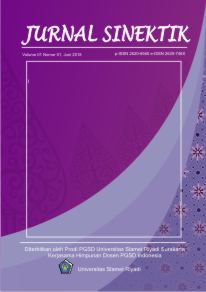DESKRIPSI KEMAMPUAN LITERASI NUMERASI SISWA MENGGUNAKAN POLYA DITINJAU DARI GENDER
DOI:
https://doi.org/10.33061/js.v4i2.6174Keywords:
literasi numerasi, pemecahan masalah polya, genderAbstract
The purpose of this study is to examine the numerical literacy ability profile of MI students in class V in terms of gender utilizing Polya problem-solving. In this study, a descriptive qualitative technique was adopted. The research is being conducted at MIN 9 Central Aceh. Purposive sampling is used to choose study volunteers. The data analysis approach developed by Miles and Huberman was employed in this investigation. According to the study's findings, the pupils' numeracy literacy test scores depending on gender have remained in the 40 range, which was classified as poor. According to the findings of the interviews and research, both male and female students struggled to comprehend the problem at the beginning. Male and female students are unable to create solutions, execute solutions, or review replies because they do not grasp the problem.
References
Aini, N. N., & Mukhlis, M. (2020). Analisis Kemampuan Pemecahan Masalah Pada Soal Cerita Matematika Berdasarkan Teori Polya Ditinjau Dari Adversity Quotient. Alifmatika: Jurnal Pendidikan Dan Pembelajaran Matematika, 2(1), 105–128. https://doi.org/10.35316/alifmatika.2020.v2i1.105-128
Ayuningtyas, N., & Sukriyah, D. (2020). Analisis Pengetahuan Numerasi Mahasiswa Matematika Calon Guru. Jurnal Delta-Pi,. 9(2), 237–247.
Cooper, B. (2000). Assessing children ’ s mathematical knowledge Social class , sex and problem-solving Barry Cooper and M á ir é ad Dunne. February 2014.
Fery, M. F., Wahyudin, & Tatang, H. (2017). Improving primary students mathematical literacy through problem based learning and direct instruction. Educational Research and Reviews, 12(4), 212–219. https://doi.org/10.5897/err2016.3072
Isnarto, M. M. L. (2016). Analisis Kemampuan Pemecahan Masalah Ditinjau Dari Karakteristik Cara Berpikir Siswa Dalam Model Problem Based Learning. Unnes Journal of Mathematics Education., 5(1). https://doi.org/10.15294/ujme.v5i1.9343
Kompas. (2020). Apa itu Assesmen Kompetensi Minimum? Simak Penjelasannya. Kompas.com.
Ma’sum, A. (2014). Profil Kemampuan Penalaran Matematis siswa dalam menyelesaikan bangun ruang sisi lengkung. Prodi Pendidikan Matematika. STKIP Jombang.
Mahmud, M. R., & Pratiwi, I. M. (2019). Literasi Numerasi Siswa Dalam Pemecahan Masalah Tidak Terstruktur. Jurnal KALAMATIKA, 4(1), 69–88.
Noviani, J. (2019). Analisis Kesalahan Mahasiswa Menurut Tahapan Kastolan dan Pemecahan Masalah Matematika Finansial Model Polya. Jurnal Ilmiah Pendidikan Matematika: AL-QALASADI, 3(1), 27–39.
OECD. (2016). PISA 2015 Results (Volume I): Excellence and Equity in Education. In PISA.https://doi.org/10.1787/9789264266490-en.
OECD.(2019). PISA 2018 insights and interpretations. In OECD Publishing.
Polya, G. (1985). How To Solve It (A New Aspect of Mathematical Method). United States of America:Princeton University Press.
Rahmawati, & Mahdiansyah. (2014). Literasi Matematika Siswa Pendidikan Menengah: Analisis Menggunakan Desain Tes Internasional dengan Konteks Indonesia. Jurnal Pendidikan Dan Kebudayaan, 20, 452–469.
Safitri, I. N. (2016). Analisis Kemampuan Literasi Matematis Siswa Dalam Perspektif Gender. Skripsi.Universitas Islam Negeri Sunan Ampel Surabaya.
Sari, R. H. N., & Wijaya, A. (2017). Mathematical literacy of senior high school students in Yogyakarta. Jurnal Riset Pendidikan Matematika, 4(1), 100. https://doi.org/10.21831/jrpm.v4i1.10649
Sepriyanti, N., & Julisra, W. (2019). Kemampuan Literasi Matematis Peserta Didik Dalam Perspektif Gender Di Kelas X Mia 7 Sman 10 Padang. Math Educa Journal, 3(2), 195–206.
Simalango,Maria, M., Darmawiijoyo, & Aisyah, N. (2018). Kesulitan Siswa Dalam Menyelesaikan Soal-Soal PISA Pada Konten Change And Relationship Level 4,5,6 di SMP N 1 Indralaya. Jurnal Pendidikan Matematika, 11(2), 43–58. https://doi.org/10.22342/jpm.11.2.2143.
Suganda, V. A. (2014). Analisis Kesulitan dalam Menyelesaikan Soal Pemecahan Masalah dan Sikap Matematis Siswa Kelas V Sekolah Dasar. Tesis. Universitas Pendidikan Indonesia.
Sugiyono. (2016). Metode Penelitian Kuantitatif, Kualitatif, dan R&D. Bandung:PTAlfabet.
Tim GLN. (2017). Materi Pendukung Literasi Numerasi. Jakarta:Kemdikbud.
Tyas, F., & Pangesti, P. (2018). Menumbuhkembangkan Literasi Numerasi Pada Pembelajaran Matematika Dengan Soal Hots. Indonesia Digital Journal of Mathematics and Education, 5(9), 566–575.
Zainiyah, U. (2018). Literasi Matematika: Bagaimana jika Ditinjau dari Kemampuan Pemecahan Masalah Matematika Siswa SD Kelas Tinggi?. Jurnal Riset Pendidikan Matematika, 4(1), 5–14. http://journal.uny.ac.id/index.php/jrpm Jurnal
Downloads
Published
Issue
Section
License
Copyright (c) 2021 Jurnal Sinektik

This work is licensed under a Creative Commons Attribution-NonCommercial 4.0 International License.
Authors who publish this journal agree to the following terms:
- Authors retain copyright and grant the journal right of first publication with the work simultaneously licensed under a Creative Commons Attribution License that allows others to share the work with an acknowledgement of the work's authorship and initial publication in this journal.
- Authors can separately make additional contractual arrangements for non-exclusive distribution published by the journal (e.g., publish it in a book), with an acknowledgement of its initial publication in this journal.
- Authors are allowed and encouraged to send their work via online (e.g., in the institutional repositories or their website) after published by the journal.














